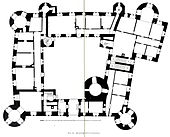Montabaur Castle
The baroque Montabaur Castle is the landmark of the city of Montabaur in the Westerwald . It is visible from afar in the city center on the Schlossberg at an altitude of 321 meters above sea level and today serves as a training and conference center for the Academy of German Cooperatives .
description
The castle consists of a bailey and a two-storey main building, which with its four wings surrounds an almost square inner courtyard. At the corners it has three-storey round towers with a flat, curved hood as a roof. Its medieval keep is 33 meters high. On the courtyard side, three stair towers emerge from the yellow-painted facade.
A few individual buildings still belong to the palace complex, including the baroque redesigned Zwinger , the Marstall from 1720 and the outer gate dating from 1588.
history
The history of the castle goes back to the 10th century. In 959 a "Castellum Humbacense" was first mentioned in a document as the residence of Duke Hermann of Swabia . In 1018, Emperor Heinrich II transferred the castle and the lordship that belonged to it to the Archbishop of Trier Poppo von Babenberg and thus to the Archdiocese of Trier . Archbishop Theoderich von Wied had it fortified to secure the areas on the right bank of the Rhine of his diocese , but could not prevent the castle from being attacked and destroyed by the Count of Nassau in 1212 . Inspired by Mount Tabor in Israel , Theodoric had the complex rebuilt in 1217 and named the castle hill "Mons Tabor", from which the later "Montabaur" developed. The facility was first mentioned in a document under this name in 1227.
The castle was subsequently administered by a castle captain. It served at the same time as the official and residence of episcopal bailiffs and was guarded by castle men . Around 1400 the number was 53. The keep of the complex was built around 1280, but around 1520 the medieval fortification was converted into a four-winged Renaissance castle , the core of which has survived to this day. Before that, Emperor Maximilian had stayed in the castle in 1505 with 500 people in his retinue .
The castle got its present appearance in the years from 1687 to 1709, when Elector Johann Hugo von Orsbeck had it redesigned in the Baroque style by his court architect Johann Christoph Sebastiani . The ceiling painting is by Lazaro Maria Sanguinetti . It depicts allegories of light and personifications of the four elements air, earth, fire and water. The complex served as the residence of the Archbishops of Trier until the end of the 18th century, before the last elector, Clemens Wenzeslaus of Saxony , fled from the French revolutionary armies in 1794 the electoral state was abolished in 1801. The former Trier possessions - and with it Montabaur Castle - fell to the Duchy of Nassau-Weilburg. The Dukes of Nassau subsequently used the complex as a hunting lodge .
From 1851 until 1880 the building was the seat of the ducal-Nassau simultaneous school teacher seminar. From 1868 they served as the seat of the district office and until 1945 also as the apartment of the district administrator of the Unterwesterwaldkreis . After the Second World War, the castle was used as the administrative seat of the administrative district of Montabaur from 1946 onwards.
In 1969 the Deutsche Genossenschaftskasse acquired the facility, which was then used by the Schulze-Delitzsch-Institut and the Bundesgenossenschaftsschule Raiffeisen eV. After the two institutes merged in 1978 to form the Academy of German Cooperatives, the latter bought the castle and converted it into a seminar and conference center.
Current usage
Since 1970 Schloss Montabaur has served as a nationwide center for the management qualification of prospective and current managers of the cooperative banks and the cooperative goods, trade and service cooperatives. The Academy of German Cooperatives also operates a four-star hotel there with around 300 rooms. With over 70,000 overnight stays, Schloss Montabaur is one of the largest hotels in Rhineland-Palatinate.
literature
- Markus Wild: Montabaur Castle, insights into the historical and art-historical development of an important architectural monument . Academy of German Cooperatives, Montabaur 1995.
Web links
Coordinates: 50 ° 26 ′ 19 ″ N , 7 ° 49 ′ 34.9 ″ E





